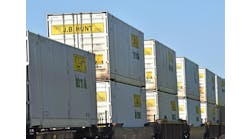Plan, Prepare and Prosper: How to Master the Busy Holiday Season
With summer 2017 now in the rear-view mirror, we face the harsh reality that the holiday season is just ahead, and for retailers, that translates into their busiest time of the year. In fact, retailers are already well into the process of preparing their warehouses and supply chains for the 2017 holiday sales spike. The truth is, excellent peak season execution requires year-round focus—if retailers failed to dive back into planning shortly after the 2016 holiday season wrapped up, they may find themselves struggling to keep up with the competition.
The rise of e-commerce and the growing “instant gratification” consumer mentality has only exacerbated the need for early and thoughtful peak season preparation. The year-over-year growth of e-commerce continues, and according to the National Retail Federation, the industry will see 8-12% growth this year. This might not sound like much of a difference, but the multi-year compounding effect over the last decade has forced retailers to significantly revamp processes in their warehouses around the world.
To facilitate seamless end-to-end omni-channel sales through the biggest shopping season of the year, retailers need to ready their distribution centers well in advance to keep ahead of the holiday rush. To master the busy holiday season, retailers must plan and prepare in order to prosper. Start by tackling the following five rules.
1. Start Early
We all know that holiday shopping behavior is tied to specific, stationary calendar events, so there is no excuse for not planning and preparing well in advance. The best practice of leading retailers includes starting holiday peak season planning and preparations as early as February. By spring and summer, these retailers have advanced past the stages of basic prep and are focused on implementing new software modules and making physical changes to augment their warehouse throughput capabilities for the upcoming holiday season.
Key distribution systems used for the holiday season should be up and running by September. This timeline speaks for itself—it’s critical to get the wheels in motion as soon as last season’s returns have been processed.
2. Elongate Your Peak Season
In recent years, leading retailers have implemented thoughtful and synchronized initiatives aimed at elongating their holiday sales periods. Spreading your holiday sales over a longer period of time reduces extreme peaks and will take some of the stress off of your warehouse systems and personnel. Instead of offering e-commerce sales incentives on just a handful of days, retailers are stretching their holiday marketing efforts across an elongated timeframe.
Of course, this isn’t helpful if it’s not precisely coordinated with the back-end supply chain and warehousing functions. Further, it’s not effective if the supply chain planning functions did not purchase and feed inventory into the appropriate locations months in advance. Orchestration of purchasing, marketing and fulfillment is vital—not enough of the right inventory in the right places, ill-timed marketing, and/or not enough warehouse capacity is a recipe for trouble.
Early holiday product placement in stores and distribution centers, along with synchronized marketing, prompts consumers to start thinking about holiday necessities. Halloween costumes and candy in late summer might seem taboo, but it gets consumers thinking about what they might need for the holiday. These strategies are enabling successful omni-channel retail sales in stores and online across a longer period of time, which alleviates spikes and pressure on supply chain operations.
3. Perform Warehouse Stress Tests
Retailers should think about Labor Day and smaller holidays as opportunities to stress-test their facilities with their new systems and procedures in place. In doing this, retailers will have righted any operational or systems issues well before the big holidays produce massive volume through the business. In this same timeframe, it’s important to doublecheck that your supply chain software is up to date and properly configured so that your teams have access to all of the functionality they will need. Your warehouse should be able to scale up and down quickly and efficiently during this time of massive demand fluctuation.
One way to gauge flexibility and scalability in the warehouse is to perform “compression tests” prior to the holiday peak season. This is a process where a retailer will place an artificial hold on a large number of orders and then flood the system with volume, thereby placing the operation under peak season volume conditions. As substantial volumes are processed through the systems, interfaces, devices and equipment, the test provides a representative picture of how things will flow during peak. More importantly, it provides an excellent opportunity to learn and improve before peak. Processes can be improved, personnel can be trained, and systems can be tuned based on results and observations. However you choose to go about them, testing your warehouse systems and operational flows will undoubtedly identify opportunities for improvement.
4. Arm Your Temporary Workforce
Hundreds of thousands of employees join the seasonal retail supply chain workforce for the holidays, and far too many of them are given large, antiquated devices with small screens and huge keyboards that are difficult to acclimate to. These temporary workers need devices that are rugged enough for the job, but the software and hardware should be modern, intuitive and familiar. Simplicity and a “zero training” functionality are key to driving productivity from the seasonal workforce.
Personnel should be armed with technology that emulates the consumer technology they use every day, like personal smartphones and tablets. It’s not uncommon for e-commerce peak season volumes to be 10 times larger than typical shipping volumes, so distribution leaders know that reducing ramp-up time for temporary associates is critical to their peak season success.
One of the biggest mistakes you can make during the holiday season is poorly executing the onboarding of your temporary workforce. If this critical process is mishandled, you’ll have a tremendous order and inventory backlog and employees who are getting in the way instead of helping to solve problems and drive throughput.
5. Follow Through
As retailers know all too well, the customer engagement process doesn’t always end after the credit card is swiped and the consumer has their merchandise. Returns are a big part of the holiday season, and today’s consumers expect to be reimbursed quickly. Consumer-friendly returns and exchange policies are very common in today’s competitive landscape, especially for e-commerce transactions.
The customer service call center operation and systems are a great place to inspect and refine ahead of the holiday season. In order to exceed customer expectations, retailers need to have call center application workflows that help employees properly engage with customers and easily answer their questions on order status, updates, returns and exchanges. When integrated to warehouse and store systems, new merchandise can be shipped to a customer quickly and any returned products can be processed rapidly.
When returned merchandise arrives at your distribution center, it’s important to have designated processes and systems that are tailored to what is typically a rather complex returns workflow. Well-designed warehouse return stations allow personnel to quickly record the inspection and disposition of returned products. It’s important to the business that returned products be sorted into categories like “damaged,” “first quality,” or “marked for return to the upstream vendor.” If the product is deemed first quality and is therefore a re-sellable asset, it’s important that it is processed promptly upon arrival at the facility. Delays increase inventory holding costs and slow return processes delay customer credits, which decreases customer satisfaction.
Each year, experts make valid predictions, but it’s impossible to know exactly which challenges the coming holiday season will bring to the warehouse. Will a viral video cause demand for one particular product to skyrocket? Will your distribution center see its worst winter yet, causing shipping delays and disgruntled customers? There’s no telling what this holiday season will bring, and no one knows the hard-hitting truth like retailers who have failed to properly prepare.
In today’s e-commerce driven world, where negative consumer reviews can be found with a simple online search, retailers are bound to feel the sting for a sustained period if service, delivery, or distribution issues caused consumer strife. It’s important to gain control of what you can—well in advance. By following these tips, you’ll be sure to have a promising start to the holiday season and a happier, more profitable new year.
Eric Lamphier is senior director of product management with Manhattan Associates, a provider of supply chain software.



